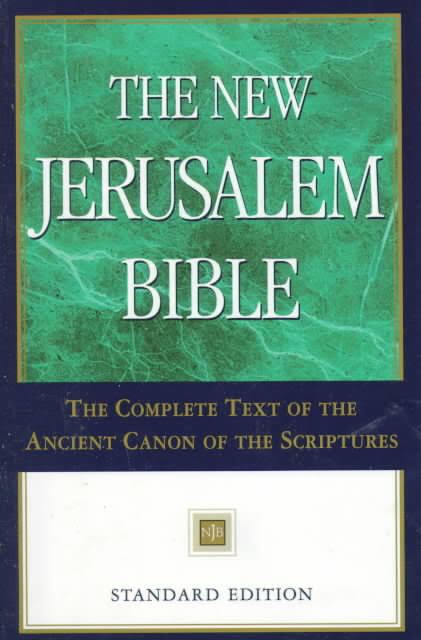8.2 /10 1 Votes8.2
Reading level High school Complete Bible published 1985 | 4.1/5 iTunes - Apple Abbreviation NJB | |||||||||||||||||||||||||||||||||
 | ||||||||||||||||||||||||||||||||||
Textual basis NT: Novum Testamentum Graece 25th ed., with occasional parallels to Codex Bezae. OT: Biblia Hebraica Stuttgartensia with Septuagint influence. Deuterocanon: Septuagint with Vulgate influence. Translation type Free, largely dynamic translation Publisher Darton, Longman and Todd and Les Editions du Cerf Similar Henry Wansbrough books, Biblical studies books | ||||||||||||||||||||||||||||||||||
The New Jerusalem Bible (NJB) is an English-language translation of the Bible published in 1985 by Darton, Longman and Todd and Les Editions du Cerf, edited by the Reverend Henry Wansbrough and approved for use in study and personal devotion by Roman Catholics.
Contents
Contents
The New Jerusalem Bible includes the deuterocanonical books and sections. The text of these is included where they occur in the context of the complete Septuagint, rather than being grouped together in an appendix. Deuterocanonical sections of books in the Hebrew canon are identified by the use of italics.
Overview
The New Jerusalem Bible is an update to the Jerusalem Bible, an English version of the French Bible de Jérusalem. It is commonly held that the Jerusalem Bible was not a translation from the French; rather, it was an original translation heavily influenced by the French. This view is not shared by Henry Wansbrough, editor of the New Jerusalem Bible, who writes, "Despite claims to the contrary, it is clear that the Jerusalem Bible was translated from the French, possibly with occasional glances at the Hebrew or Greek, rather than vice versa."
When the French version was updated in 1973, the changes were used to revise the Jerusalem Bible, creating the New Jerusalem Bible. The revisions were substantial. The revised version is said to be less literary but, for the most part, more literal. The introductions and footnotes, translated almost entirely from the French, have also been thoroughly revised and expanded, making it one of the most scholarly editions of the Bible.
The translation uses some inclusive language, as in Exodus 20:17: "You shall not set your heart on your neighbor's spouse," rather than "neighbor's wife" or "neighbor's woman". For the most part, however, the inclusive language is limited to avoiding a "preference" for the masculine, as the translators write in the foreword. The New Jerusalem Bible uses more gender inclusive language than the Jerusalem Bible, but far less than many modern translations such as the New Revised Standard Version Catholic Edition, which changes "brothers" to "brothers and sisters", throughout the New Testament. For the inclusive language that it does contain, it has been rejected by many conservative American Catholics in favor of the Revised Standard Version Catholic Edition or the Douay-Rheims Bible. Outside of America it has become the most widely used Catholic translation in English-speaking countries.
Like the Jerusalem Bible, the New Jerusalem Bible makes the uncommon decision to render God's name, the Tetragrammaton, in the Jewish scriptures as Yahweh rather than as Lord or Jehovah which is consistently rendered Yahweh in 6,823 places of the NJB Old Testament. However, "Lord" is a translation of "Adonai". Further, this decision is based on translating or reinstating the earliest known copy of parts of the Old Testament found at Qumran in 1947 (the Dead Sea Scrolls), dating to about the second century BCE. Coincidentally, the Qumran text often agrees with the Septuagint, from about the same period, rather than with the later Masoretic text. For example, in Deuteronomy 32:8-9, not only is "Lord" translated as Yahweh, but a phrase "sons of Israel" is corrected to "sons/children of God" on basis of the Qumran and the Septuagint texts. The NJB is one of the versions authorized to be used in services of the Episcopal Church and the Anglican Communion.
The New Jerusalem Bible also transliterates the Hebrew term "Sabaoth" rather than using the traditional rendering, thus "Yahweh Sabaoth" instead of "Lord of hosts". This is for the sake of accuracy, as the translation of "Sabaoth" is uncertain.
Also, the NJB transliterates the Hebrew "Shaddai" in the book of Job and elsewhere in the OT. Most translations render "El Shaddai" as "God Almighty", but the NJB simply transliterates the Hebrew as "El Shaddai".
Successor to the NJB
The French reference for The New Jerusalem Bible, and the source of its study notes, is the French La Bible de Jérusalem, last updated in 1998. The new Bible project is currently operating under the title The Bible in its Traditions. According to the notes, more weight will be given to the Septuagint in the translation of the Hebrew Bible Scriptures, though the Masoretic Text will remain the primary source. The Demonstration Volume (in English, French and Spanish) is available now. The French portion of the Demonstration Volume is available online, together with a single sample of the English translation. In this new version, the tetragrammaton is not transliterated as in the Jerusalem Bible and the New Jerusalem Bible, and several kinds of commentary are included in a manner different from the practice of other Bible editions.
